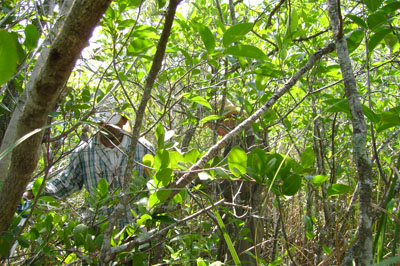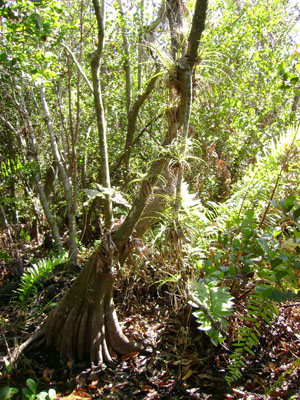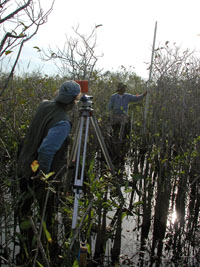 Flooding characterizes south Florida freshwater swamp forests, which range from those inundated for only a few months every year to others in which water recedes below the surface only in occasional drought years. In Everglades National Park (ENP), these forests are dominated by a suite of eight, mostly temperate tree species: pond apple (Annona glabra), wax myrtle (Morella cerifera), sweetbay (Magnolia virginiana), cocoplum (Chrysobalanus icaco), coastal plain willow (Salix caroliniana), redbay (Persea borbonia), dahoon holly (Ilex cassine), and baldcypress (Taxodium distichum). In the swamp forests of the Big Cypress National Preserve, red maple (Acer rubrum), pop ash (Fraxinus caroliniana), and swampbay (Persea paulustris) become important components. Under certain conditions, swamp forests form tall, closed canopies, while in others the tree layer is low and open, with a rich understory of ferns, graminoids, and herbaceous species. Buttonbush (Cephalanthus occidentalis) is a common shrub in these open forests.
Flooding characterizes south Florida freshwater swamp forests, which range from those inundated for only a few months every year to others in which water recedes below the surface only in occasional drought years. In Everglades National Park (ENP), these forests are dominated by a suite of eight, mostly temperate tree species: pond apple (Annona glabra), wax myrtle (Morella cerifera), sweetbay (Magnolia virginiana), cocoplum (Chrysobalanus icaco), coastal plain willow (Salix caroliniana), redbay (Persea borbonia), dahoon holly (Ilex cassine), and baldcypress (Taxodium distichum). In the swamp forests of the Big Cypress National Preserve, red maple (Acer rubrum), pop ash (Fraxinus caroliniana), and swampbay (Persea paulustris) become important components. Under certain conditions, swamp forests form tall, closed canopies, while in others the tree layer is low and open, with a rich understory of ferns, graminoids, and herbaceous species. Buttonbush (Cephalanthus occidentalis) is a common shrub in these open forests.
 Swamp forests occupy a broad spectrum of physiographic positions. In the prairies at the periphery of the Everglades, they often occupy modest outcrops, and are dry for much of the year. Cypress domes typically form over bedrock depressions, as do many of the bayheads found in the coastal Everglades. In many of these cases, the forest sediments build up more rapidly than those of the surrounding marsh, eventually forming a topographic high. Swamp forests also develop on the downstream side of forested outcrops in the peatlands of Shark River Slough, ENP, giving the resultant tree island a
Swamp forests occupy a broad spectrum of physiographic positions. In the prairies at the periphery of the Everglades, they often occupy modest outcrops, and are dry for much of the year. Cypress domes typically form over bedrock depressions, as do many of the bayheads found in the coastal Everglades. In many of these cases, the forest sediments build up more rapidly than those of the surrounding marsh, eventually forming a topographic high. Swamp forests also develop on the downstream side of forested outcrops in the peatlands of Shark River Slough, ENP, giving the resultant tree island a  characteristic tear-drop shape. The swamp forest tails of these large landforms may reach 1 km or more in length, sloping almost imperceptibly downward from a closed canopy forest near the head to more open, herb- and shrub-dominated vegetation at the distal end.
characteristic tear-drop shape. The swamp forest tails of these large landforms may reach 1 km or more in length, sloping almost imperceptibly downward from a closed canopy forest near the head to more open, herb- and shrub-dominated vegetation at the distal end.
Freshwater swamp forests comprise less than 10% of the Everglades, but contribute disproportionately to its wildlife, especially as roosting habitat for wading birds. In the northern Everglades in particular, forested islands were once much more prevalent than they are today. Many of these islands have experienced massive tree die-off in recent decades, due to assorted combinations of unnaturally high water and devastating fires. The recovery and reestablishment of these forests into the landscape is an important objective of the Everglades restoration.